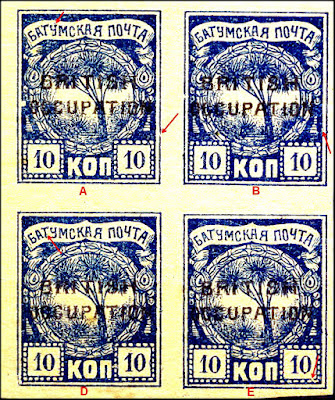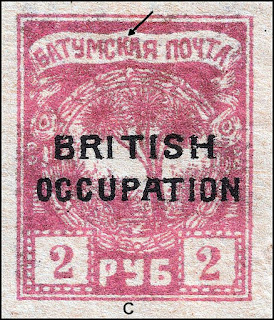Transfer Blocks
As noted, each value was printed in a transfer block of 6 subjects (described as A,B,C,D,E,F)
Unfortunately, I do not have blocks of 6 for all values so a list of the characteristics will have to do in most cases.
5K
A. Small left 5 high in value box.
B. Left hand value tablet spot under 5
C. Left 5 appears slanted, right 5 has large lower half.
D. Frame Break in frame at SE corner, very large low left 5, right 5 is much smaller and higher.
E. Frame thick blob on frame opposite bottom right hand step.
F. Dot inside frames opposite left 5, left 5 has sharply upturned top.
10K
A. Break in the frame at the right 7 mm. up from the corner and a group of dots around the top of the Y.
B. A cut into the solid colour close to the frame at the right 8 mm. up from the corner where there is a group of dots.
C. A line linking the right frame to the solid background 7.0 mm. below top corner.
D. A dot of colour to the right of "T" of "Batumskaya".
E. A gap in the frame of the right value tablet joining up the white space to the lower right pearl.
F. Dots of colour outside the top frame line.
25K
The positioning and shape of the numerals is key to the ID for this value
A. Left hand value tablet 2 just touches side & the 5 almost touches the frame. In the right tablet the 25 is well spaced with the 2 slightly larger.
B. Both 2's are much larger than the 5's
C. Both 25's are widely spaced and almost touching the sides
D. Left hand value tablet 2 and 5 are large and wide apart.
E. Right hand value tablet spot above 2, left 2 appears slanted right.
F. Left hand value tablet spot inside 2 near ball
1R
A. Scroll Spot under left hand arm of T of POCHTA
B. Top frame break slightly right of centre
C. Top frame two breaks towards the middle
D. Right hand value tablet spot near SE corner
E. Right frame Said to be a spot near SE corner beyond frame
F. Left hand value tablet stroke beneath and close to l
2R
A. Right frame weakening - sometimes a break near SE corner
B. Scroll spot above U of BATUMSKAYA
C. The K of BATUMSKAYA is slightly smaller and raised
D. Outer Frame Under U of RUB background and frame joined
E. Left hand value tablet break in top of 2
F. Right Frame Break in frame about one-third way down
3R
A. Scroll line of colour joining YA to bottom of scroll
B. Outer frame blob of colour at SW corner
C. White line pointing SE below letter R of RUB & spots in right hand 3 tablet
D. Scroll right leg of K broken
E. Right hand value tablet noticeable colour spot to SW of 3
F. Scroll spot at top right of T in POCHTA
5R
A. A clear diagonal stroke close to the top of the A of Batumskaya
B. Right frame line thickened and protruding slightly at the corners.
C. Above scroll, near K a small triangular piece of white
D . There is a clear break in the body of the first letter in BATUM
E. There is a very fine sloping line just above the K of Batumskaya but it is not always clearly visible.
F. A small thin white diagonal line just touching the top of the R of RUB
7R
A. A very small spot of colour above the M of Batumskaya
B. A break in the left tablet allowing it to join up with the fifth pearl from the left.
C. A dot close to to the right 7 but this is not always visible
D. A fine vertical line 0.5 mm. to the left of the left 7
E. Each 7 is high in its tablet
F. There is a very small nick in the outer edge of the frame line at the top left
Forgeries (Fakes)
There are 3 Types - Type I (common), Type II (very common), Type III ( very scarce)
Most offerings on auction sites are fakes
NOTE - The Type I fake overprint appears on the Type I aloe tree forgery, the Type II on the Type II aloe tree forgery discussed in an earlier blog.
The Type II is immediately noticeable by the rougher, cruder base stamp.
Below are the main features of the fake overprints.
Type I - the most prominent features are the curved foot on the R, the large SH and the small N.
Type II - the most prominent features are the wide squat tops of the BR, the straight leg of the R, the square shaped S and the large N.
Comparison of the 8 values - the Type I on the left, Type II on the right
The last 7R is a Type II - no Type I image available
Type III Forgery
The third series of forgeries is extremely scarce and has only been found as mint singles.
The key feature is the extremely small overall size of the overprint, letters are only 1.5 mm. high
The design is also VERY crude as the base stamp is the basic aloe tree Type III forgery.
I can only show a sample from a catalog.




















No comments:
Post a Comment
THANK YOU for the feedback. Your comment will be reviewed and appear on this blog within 24 hours
Do you have any pic to share? Use this code [img]your-image-url-here[/img]